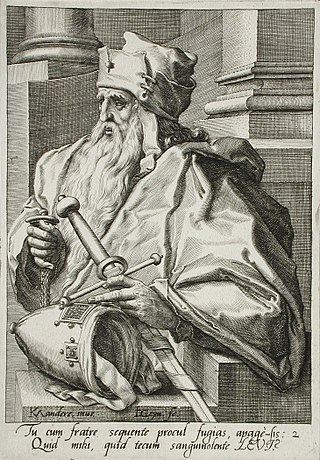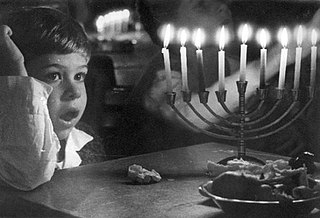
According to Abrahamic religions, Aaron was a prophet, a high priest, and the elder brother of Moses. Information about Aaron comes exclusively from religious texts such as the Hebrew Bible, the New Testament, and the Quran.
Levites or Levi are Jewish males who claim patrilineal descent from the Tribe of Levi. The Tribe of Levi descended from Levi, the third son of Jacob and Leah. The surname Halevi, which consists of the Hebrew definite article "ה" Ha- ('the') plus Levi ('Levite'), is not conclusive regarding being a Levite; a titular use of HaLevi indicates being a Levite. The daughter of a Levite is a Bat Levi.
Kohen is the Hebrew word for "priest", used in reference to the Aaronic priesthood, also called Aaronites or Aaronides. They are traditionally believed and halakhically required to be of direct patrilineal descent from the biblical Aaron, brother of Moses, and thus belong to the Tribe of Levi.

According to the Hebrew Bible, the tabernacle, also known as the Tent of the Congregation, was the portable earthly dwelling used by the Israelites from the Exodus until the conquest of Canaan. Moses was instructed at Mount Sinai to construct and transport the tabernacle with the Israelites on their journey through the wilderness and their subsequent conquest of the Promised Land. After 440 years, Solomon's Temple in Jerusalem superseded it as the dwelling-place of God.

Levi was, according to the Book of Genesis, the third of the six sons of Jacob and Leah, and the founder of the Israelite Tribe of Levi and the great-grandfather of Aaron, Moses and Miriam. Certain religious and political functions were reserved for the Levites.
According to the Torah, Merari was one of the sons of Levi, and the patriarchal founder of the Merarites, one of the four main divisions among the Levites in Biblical times. The Hebrew word Merari means sad, bitter or strong. The Merarites were charged with the transportation and care of the structural components of the tabernacle.
In the Torah, Ithamar was the fourth son of Aaron the High Priest. Following the construction of the Tabernacle, he was responsible for recording an inventory to ensure that the constructed Tabernacle and its contents conformed to the vision given by God to Moses on Mount Sinai.
Richard Elliott Friedman is an American biblical scholar, theologian, and translator who currently serves as the Ann and Jay Davis Professor of Jewish Studies at the University of Georgia.
Tetzaveh, Tetsaveh, T'tzaveh, or T'tzavveh is the 20th weekly Torah portion in the annual Jewish cycle of Torah reading and the eighth in the Book of Exodus. The parashah reports God's commands to bring olive oil for the lamp, make sacred garments for the priests, conduct an ordination ceremony, and make an incense altar.

Bemidbar, BeMidbar, B'midbar, Bamidbar, or Bamidbor, is the 34th weekly Torah portion in the annual Jewish cycle of Torah reading and the first in the Book of Numbers. The parashah tells of the census and the priests' duties. It constitutes Numbers 1:1–4:20. The parashah is made up of 7,393 Hebrew letters, 1,823 Hebrew words, 159 verses, and 263 lines in a Torah Scroll. Jews generally read it in May or early June.

Naso or Nasso is the 35th weekly Torah portion in the annual Jewish cycle of Torah reading and the second in the Book of Numbers. It constitutes Numbers 4:21–7:89. The parashah addresses priestly duties, camp purification, restitution for wrongs committed, the wife accused of unfaithfulness, the nazirite, the Priestly Blessing, and consecration of the Tabernacle. Naso has the largest number of letters, words, and verses of any of the 54 weekly Torah portions. The parashah is made up of 8,632 Hebrew letters, 2,264 Hebrew words, 176 verses, and 311 lines in a Torah Scroll.

Behaalotecha, Behaalotcha, Beha'alotecha, Beha'alotcha, Beha'alothekha, or Behaaloscha is the 36th weekly Torah portion in the annual Jewish cycle of Torah reading and the third in the Book of Numbers. The parashah tells of the Menorah in the Tabernacle, the consecration of the Levites, the Second Passover, how pillars of cloud and fire led the Israelites, the silver trumpets, how the Israelites set out on their journeys, the complaints of the Israelites, and how Miriam and Aaron questioned Moses. The parashah comprises Numbers 8:1–12:16. It is made up of 7,055 Hebrew letters, 1,840 Hebrew words, 136 verses, and 240 lines in a Torah Scroll.

Korach or Korah is the 38th weekly Torah portion in the annual Jewish cycle of Torah reading and the fifth in the Book of Numbers. It tells of Korach's failed attempt to overthrow Moses.
In Judaism, the instructions of the priests are the rulings and teachings of the priests that are addressed to the Jewish people. Numerous Biblical passages attest to the role of the priests in teaching Torah to the people and in issuing judgment. Later rabbinic statements elaborate on these roles. However, the priest's religious authority is not automatic: even a bastard who is a scholar takes precedence over an ignorant high priest.
The commandment to sanctify the progeny of Aaron is a commandment based in the Hebrew Bible, and developed in rabbinical teaching that requires believers in Judaism to sanctify their priests (kohanim) in various ways. These include assisting him to abstain from any prohibitions in the Law that apply to him, and by affording him first rights in areas relating to holiness and the service of God. In the enumeration of Maimonides this is the 32nd positive commandment of the Law.
According to Judaism, the priestly covenant is the biblical covenant that God gave to Aaron and his descendants, the kohanim. This covenant consisted of their exclusive right to serve in the Temple, and to consume sacrificial offerings and receive other priestly gifts.
The Sons of Zadok are a family of priests (kohanim), descended from Zadok, described in the prophecies of Ezekiel.
In Judaism, the priestly court was a court of Jewish law, composed of priests descended from Aaron, which operated at the Temple in Jerusalem and oversaw matters related to the priesthood and Temple rituals.
The priesthood of ancient Israel was the class of male individuals, who, according to the Hebrew Bible, were patrilineal descendants from Aaron and the tribe of Levi, who served in the Tabernacle, Solomon's Temple and Second Temple until the destruction of Jerusalem in 70 CE. Their temple role included animal sacrifice. The priests are viewed as continuing in the Kohen families of rabbinical Judaism.

1 Chronicles 6 is the sixth chapter of the Books of Chronicles in the Hebrew Bible or the First Book of Chronicles in the Old Testament of the Christian Bible. The book is compiled from older sources by an unknown person or group, designated by modern scholars as "the Chronicler", and had the final shape established in late fifth or fourth century BCE. This chapter focuses on the tribe of Levi, divided into the line of the high priests ; the three lines of the families Gershom, Kohath, and Merari ; the lines of the musicians/singers ; duties of Levites and priests ; list of high priests and the Aaronites' and Levites' settlements. It belongs to the section focusing on the list of genealogies from Adam to the lists of the people returning from exile in Babylon.











